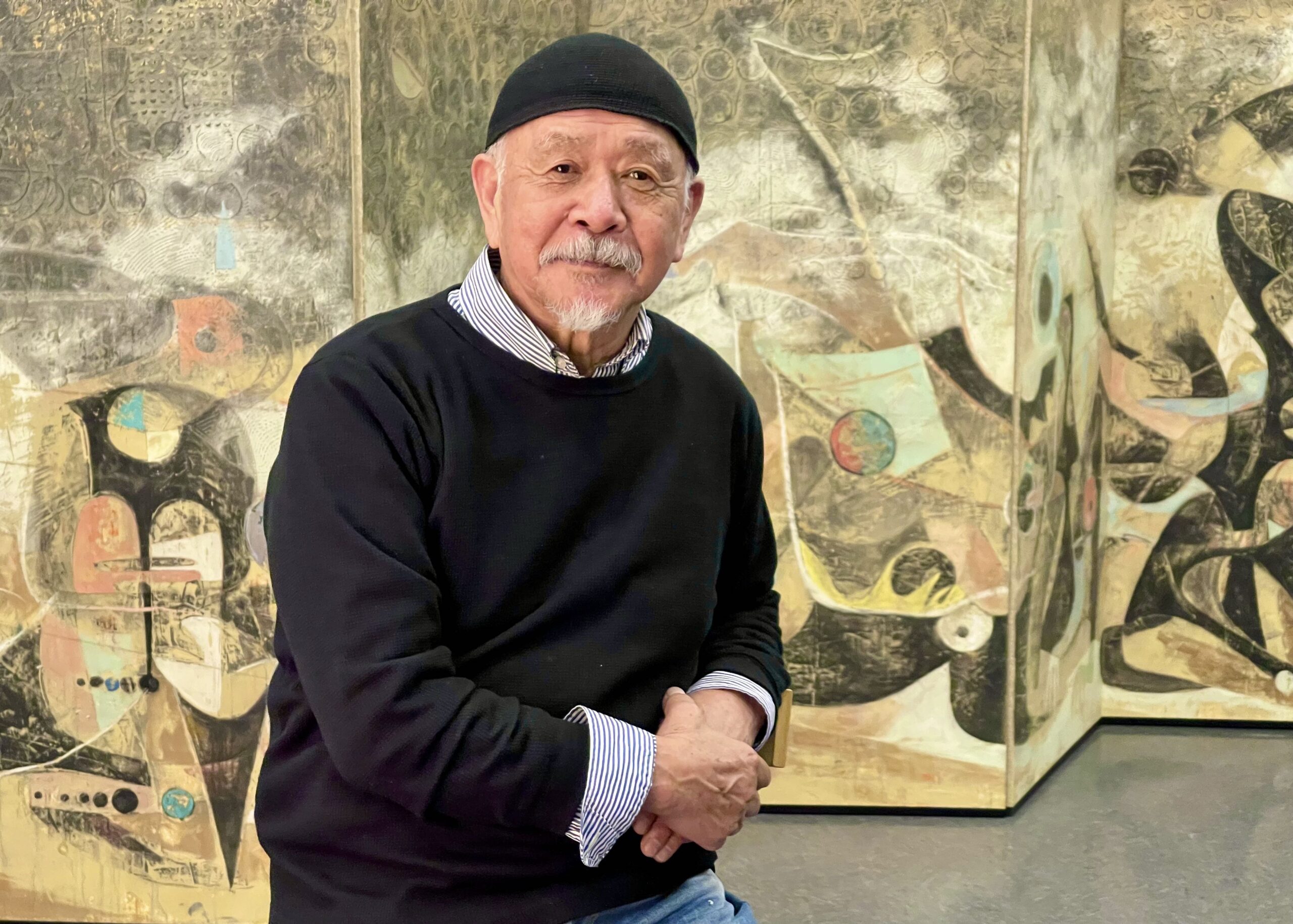By Tim Gihring //
Ken Matsubara recently stood before his most personal and certainly largest work, a 36-foot-long painting now installed in a gallery at Mia, remembering how it almost didn’t happen. In 1981, Matsubara was in his early 30s, struggling to define himself as an artist, when his mentor died, leaving him with a final, rather cryptic critique: his paintings looked “unhealthy”—in the pent-up, combustible sense of an atomic bomb.
Matsubara thought about this for a long time, almost paralyzed with doubt. Two years later, he began painting a maelstrom of raging flames and wild beasts, recalling Pablo Picasso’s Guernica. The work—actually 12 separate paintings, joined to form a kind of traditional Japanese screen—is an abstract representation of a Buddhist parable: a man is chased down a narrow path between a river of water (representing attachments and greed) and a river of fire (representing anger and hate). Only with deep focus and the guidance of Buddha can he reach enlightenment.
Now in his 70s, Matsubara explained this watershed moment of creation with the interpretive help of Mai Yamaguchi, a former curator at Mia. Painting this parable, she said, was a form of prayer, a spiritual purging of everything holding him back. Healthy mind, healthy art.
He initially called the painting, straightforwardly, Two Rivers and White Path, until an astronomer friend saw the work and declared it Chaos. Matsubara objected at first. Was the work a mess? No, the astronomer said, it was like the chaos before the Big Bang: the pure, unfiltered beginning of everything. Matsubara reconsidered. The word covered a lot of emotional ground—processing his teacher’s death, negotiating a career crossroads—so succinctly. Chaos it was.
Yamaguchi paired Chaos with the museum’s Taima Mandala, a hanging scroll from the early 1300s that depicts the Pure Land, or paradise, envisioned by the Jodo (Pure Land) sect of Buddhism. The dead, reborn into spiritual enlightenment, emerge from a lotus pond as babies, while the Amida Buddha looks on beneath a jeweled canopy. The sky is filled with flying deities and heavenly musicians.
In the gallery, the lights are low. A meditative soundtrack of reverberating singing bowls plays on repeat. Matsubara said he liked this very much. He grew up in a Buddhist temple (in Japan, temples are often overseen by families) established in the 1200s by the founder of the Pure Land sect. He learned about art from the paintings inside.
“He says that when he was painting Chaos, he was imagining the sound of temple bells,” Yamaguchi said. “It’s a kind of ideal sound, connected to a very specific chord in Shinto music.” Indeed, the tone is apparently an approximation of the lowest note generally sung by women, as in a lullaby.
Matsubara had been in the gallery for about 30 minutes, discussing his work with a handful of people—including Katie Luber, the museum’s Nivin and Duncan MacMillan Director and President, and Nivin MacMillan herself, who generously helped the museum acquire the work last year—when he realized that a crowd had gathered behind him, listening in. There were questions.
What do the circles, scattered throughout the painting, represent? The condensation of space, Matsubara replied, not unlike how the Taima Mandala compresses the essentially boundless space of heaven into a couple square yards of silk. But the circles have another meaning, as well: sounds, like those of temple bells, echoing across the canvas.
Matsubara, who lives in Tokyo, held onto Chaos for years, unable to part with such a meaningful piece. Then he turned 60—a significant age in many Asian cultures, representing five trips through the twelve signs of the zodiac—and he was ready to let it go. He offered it to a museum in Japan that was holding a retrospective of his work, but they were unable to take it. When Mia purchased Chaos, more than a decade later, he went back to the museum and informed them it was no longer available—it would now be in Minneapolis.
“They said, ‘Wow, Minneapolis?! Such an exotic place,’” Yamaguchi interpreted with a look of awe. The group laughed warmly and Mastsubara continued his story. When he finished, he placed his hands together and bowed. “He’s saying the work reflects a lot of things that happened in his life,” Yamaguchi said, “but now he’s happy—he’s reached Minneapolis.”



